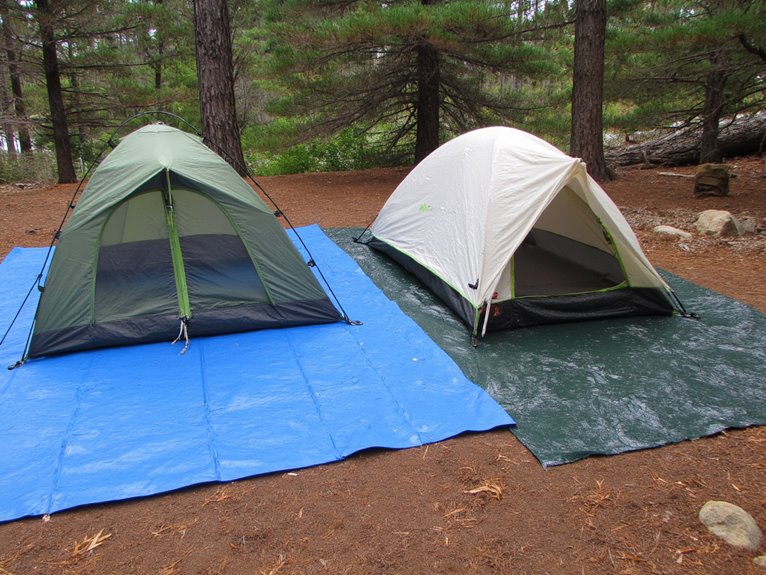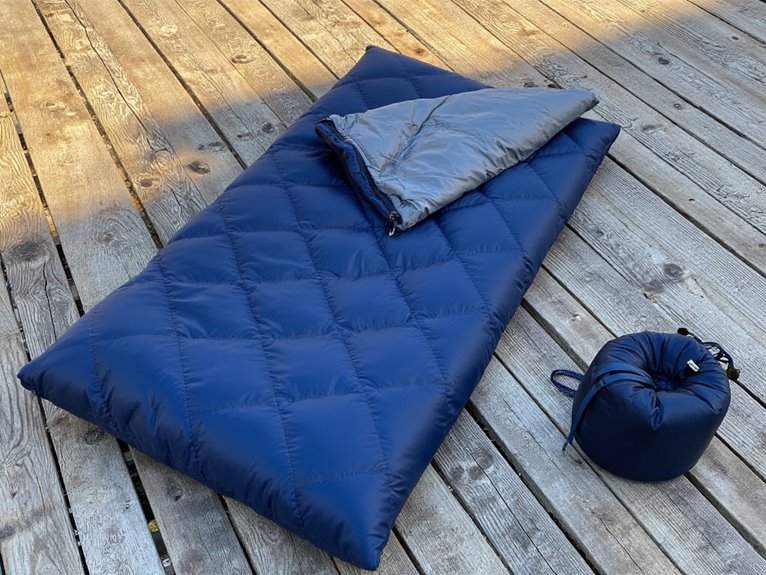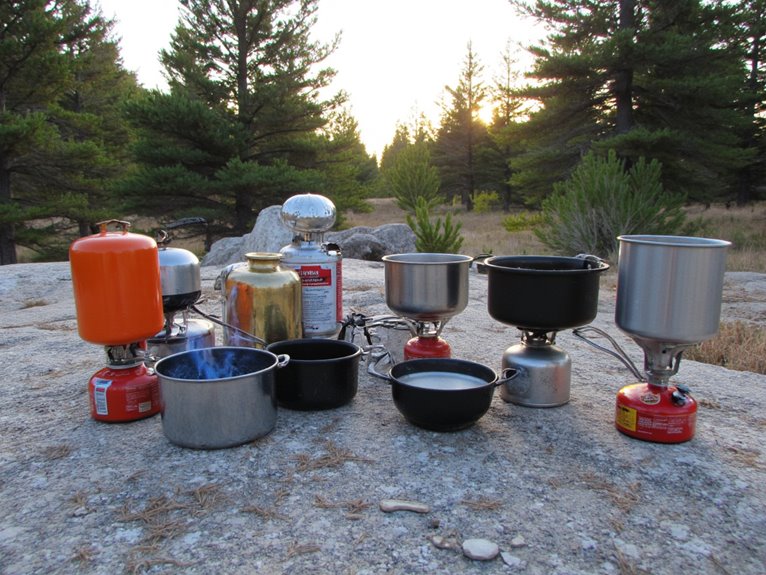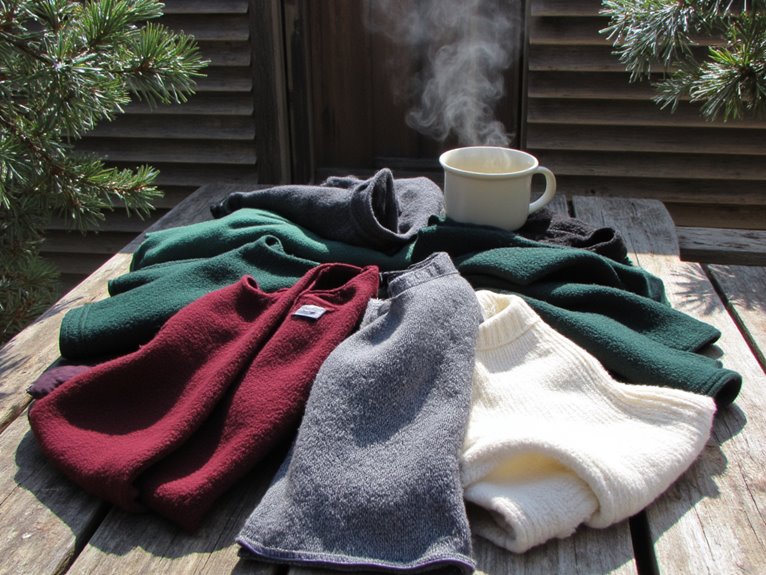Ground Sheets vs. Tent Footprints: What’s Best for Your Sleep System?
You’ll choose ground sheets for versatile positioning and moisture protection, offering quick two-minute setup with moderate abrasion resistance at $5-40. Tent footprints provide superior protection with high abrasion resistance and puncture prevention, requiring precise 3-5 minute alignment at $40-200. Ground sheets use materials like Polycryo (0.75 oz/sq yard) for lightweight comfort, while footprints employ higher denier fabrics (60D-300D) for maximum durability. Your decision depends on whether you prioritize convenience or long-term tent protection for your specific camping conditions and budget constraints.
We are supported by our audience. When you purchase through links on our site, we may earn an affiliate commission, at no extra cost for you. Learn more. Last update on 10th December 2025 / Images from Amazon Product Advertising API.
Notable Insights
- Ground sheets offer versatile positioning and quick setup, while tent footprints provide superior protection and durability for your tent floor.
- Tent footprints are tent-specific and offer high abrasion resistance, whereas ground sheets are generic accessories focusing on moisture protection.
- Footprints provide better insulation from cold surfaces and puncture prevention compared to ground sheets’ moderate protection levels.
- DIY alternatives using Tyvek or Polycro can reduce costs from $40-200 to under $30 while maintaining adequate protection.
- Ground sheets deploy in under two minutes with flexible positioning, while footprints require precise alignment taking 3-5 minutes.
Understanding the Key Differences Between Ground Sheets and Tent Footprints
While both ground sheets and tent footprints serve protective functions in camping setups, they’re fundamentally different pieces of gear with distinct purposes and placement methods.
Ground sheet features include versatile positioning options—you can place them inside or outside your tent, and some tents integrate them into the main construction. They’re designed to protect you from moisture, dirt, and cold while providing comfort and cleanliness.
Ground sheets often work as generic accessories compatible across various tent types.
Tent footprint uses focus specifically on protecting your tent floor from damage. They’re always placed beneath the tent as an external barrier against sharp objects and rough terrain.
Unlike ground sheets, footprints are typically tent-specific for ideal fit and sold separately from the main tent structure.
Material Composition and Durability Comparison

When you’re choosing between ground sheets and tent footprints, the material composition directly impacts how well they’ll protect your gear in different conditions.
You’ll find that fabric types range from ultralight Polycryo at 0.75 oz/sq yard to heavy-duty silicone-coated nylon at 2.5 oz/sq yard, each offering distinct trade-offs between weight and puncture resistance.
Understanding these material differences helps you match the right protection level to your specific camping environment and durability requirements.
Fabric Types Breakdown
Understanding the material composition of ground sheets and tent footprints directly impacts your gear’s performance, weight, and longevity in the field.
Nylon advantages include superior tear resistance and balanced weight-to-durability ratios, making it ideal for general camping applications. Different denier ratings allow you to customize strength requirements.
Polyester drawbacks center on puncture susceptibility, though it remains cost-effective for commercial footprints. Polyurethane coatings enhance water resistance but don’t greatly improve tear strength.
| Material | Weight | Durability | Best Use |
|---|---|---|---|
| Nylon | Medium | High | General camping |
| Polycryo | Lightest | Medium | Ultralight backpacking |
| Tyvek | Heavy | Highest | Harsh terrain |
Polycryo offers minimal weight for backpackers but tears easily on rough surfaces. Tyvek provides maximum tear resistance and waterproofing, though it’s heavier than alternatives.
Durability Testing Standards
Since material durability directly affects your gear’s lifespan and performance, manufacturers rely on standardized testing protocols to validate their claims.
ISO/DIS 5912 provides extensive durability benchmarks for camping equipment, establishing measurable criteria for fabric strength and longevity.
Testing methodologies include abrasion resistance tests using standardized equipment that simulates contact with rough surfaces.
Weather resistance protocols expose materials to UV radiation, temperature cycles, and moisture penetration tests.
These procedures determine how well your footprint or groundsheet will perform over extended use.
Certification requires materials to meet specific denier ratings and coating standards.
Higher denier fabrics from 60D to 300D undergo more rigorous testing than standard tent floors rated at 15D.
Independent laboratories verify manufacturer claims through repeated stress tests, ensuring you receive gear that meets documented performance specifications.
Weather Resistance Performance
Material composition determines how well your ground protection performs against rain, UV exposure, and temperature extremes.
Tyvek delivers superior weather resistance with excellent waterproofing and tear strength, making it ideal for harsh conditions.
Polycro offers lightweight convenience but sacrifices durability in rugged terrain.
Nylon provides balanced performance evaluation across weather conditions, particularly in higher denier ratings that resist abrasion and punctures.
Performance evaluation shows significant differences between materials.
Tyvek maintains structural integrity through freeze-thaw cycles and UV bombardment.
Polycro degrades faster under sustained sun exposure.
Coated nylon and polyester combinations offer reliable moisture barriers while maintaining flexibility in cold temperatures.
Your material choice directly impacts longevity.
Thicker nylon ground sheets withstand ground moisture better than ultralight alternatives.
Tyvek footprints excel in wet conditions but add pack weight.
Protection Benefits and Performance Analysis

When you’re setting up camp on rocky terrain or abrasive surfaces, both ground sheets and tent footprints serve as critical barriers between your tent floor and potential damage. These protection benefits extend your tent’s lifespan considerably by preventing punctures from sharp rocks and reducing friction-based wear. Performance analysis shows both options excel in mountainous conditions where abrasive surfaces pose the greatest threat.
| Protection Factor | Ground Sheet | Tent Footprint |
|---|---|---|
| Abrasion Resistance | Moderate | High |
| Puncture Prevention | Good | Excellent |
| Insulation Value | Low | Moderate |
| Versatility | Limited | High |
Footprints provide superior protection since they’re specifically engineered for ground contact. They also offer additional insulation against cold surfaces, reducing thermal conductivity. Ground sheets focus primarily on waterproofing rather than physical protection, making footprints the better choice for all-encompassing performance.
Cost Considerations and Value Assessment
When you’re weighing the financial aspect of ground protection, the initial cost difference between options can be substantial—ranging from $5 DIY solutions to $200 premium footprints.
Your long-term investment strategy should factor in tent replacement costs, durability expectations, and frequency of use to determine true value over time.
Budget-conscious campers have several paths forward, including homemade Tyvek sheets, generic commercial options, or brand-specific footprints that maximize protection per dollar spent.
Initial Investment Analysis
Although tent footprints require a higher upfront investment than DIY alternatives, their cost-to-protection ratio often justifies the expense. Your initial costs range from $40-200 for commercial footprints versus bulk DIY materials that cost considerably less per square foot.
Consider these investment returns when evaluating footprint options:
- Protection Value: Prevents costly tent floor replacements that typically cost $100-300
- Durability Factor: Commercial footprints last 3-5 years with proper care
- Material Performance: Polyester and nylon options offer superior puncture resistance compared to plastic sheets
- Custom Fit Premium: Manufacturer footprints include metal grommets and precise dimensions for $20-40 more than generic alternatives
DIY Tyvek costs approximately $15-25 for most tent sizes but requires cutting and customization. Your long-term savings depend on camping frequency and terrain conditions.
Long-Term Value Comparison
Over a five-year camping period, the total cost of ownership reveals significant differences between commercial footprints and DIY alternatives. Commercial footprints cost $40-200 but offer superior durability and longevity benefits. You’ll spend less replacing a $150 footprint than a $400 damaged tent.
DIY options like Polycro ($20-30) reduce initial costs but may require more frequent replacement. However, their lighter weight (2-4 ounces versus 8-12 ounces) benefits ultralight backpackers.
Footprint versatility adds value beyond tent protection. You can use them as picnic blankets, emergency rain covers, or ground sheets for gear organization.
The extended lifespan impact proves most significant. A quality footprint can double your tent’s usable life, making the $100-150 investment economically sound compared to premature tent replacement costs.
Budget-Friendly DIY Alternatives
For campers seeking maximum value, DIY footprint alternatives offer substantial cost savings without sacrificing essential protection.
Your savings strategies can reduce costs from $40-200 to under $30 using readily available materials.
Top DIY Design Materials:
- Tyvek – Durable building wrap material providing excellent waterproofing and abrasion resistance.
- Polycro – Ultralight plastic weighing 0.75 oz per square yard, ideal for weight-conscious backpackers.
- Vinyl sheets – Budget option offering moderate durability at lowest cost point.
- Repurposed tarps – Zero-cost solution using existing materials for occasional camping.
You’ll need basic cutting skills and measuring tools.
Six Moon Designs offers pre-cut options eliminating waste from bulk rolls.
DIY footprints deliver identical ground protection while allowing custom sizing for your specific tent dimensions.
Setup Requirements and Practical Usage
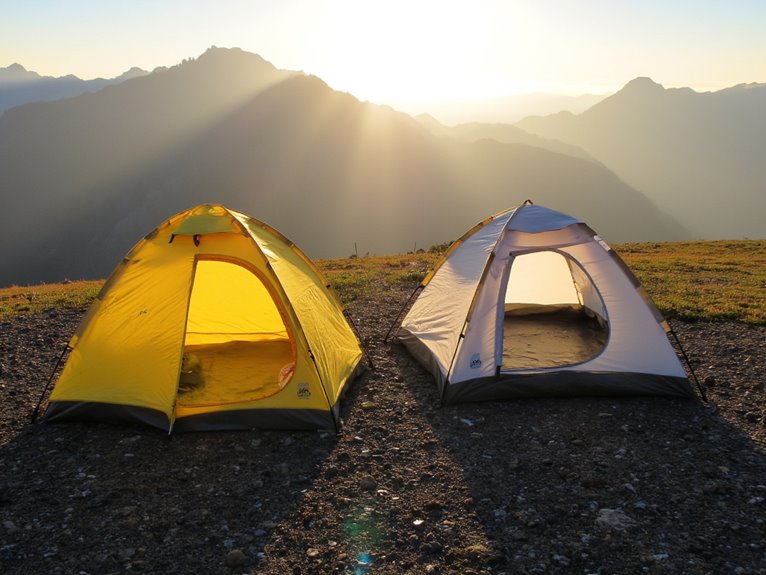
Most ground sheets require minimal setup effort and can be deployed in under two minutes with basic pegging. You’ll simply unroll the material, position it roughly under your shelter, and secure the corners with standard tent stakes. The oversized design eliminates precision requirements, making setup convenient even in challenging conditions.
Tent footprints demand more careful placement since they’re custom-cut to match your tent’s exact dimensions. You’ll need to align grommets with pole positions and guarantee proper orientation before securing.
| Feature | Ground Sheet | Tent Footprint |
|---|---|---|
| Setup Time | Under 2 minutes | 3-5 minutes |
| Positioning | Approximate placement | Precise alignment required |
| Skills Needed | Basic pegging | Moderate tent knowledge |
User experiences consistently show ground sheets offer superior setup convenience, while footprints provide better long-term tent protection despite requiring additional effort.
DIY Alternatives and Custom Solutions
While commercial ground protection costs $30-80, you can create effective DIY alternatives for under $15 using readily available materials.
DIY innovations offer significant advantages in weight reduction and cost savings. Tyvek house wrap weighs just 0.68 oz per square yard, while Polycro window film weighs only 0.34 oz per square yard.
Custom designs allow precise sizing for your specific tent footprint. Popular materials include:
- Tyvek: Waterproof, tear-resistant, available at hardware stores
- Polycro: Ultralight, cost-effective at $2 per tent footprint
- Silnylon: Waterproof but lacks structural integrity
- Waterproof polyester: Durable alternative, though noisier than other options
Seven Moon Designs offers pre-cut Tyvek kits for $12-18.
Custom solutions can incorporate reinforced corners using seam tape, creating professional-grade performance at a fraction of commercial pricing.

